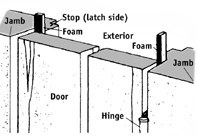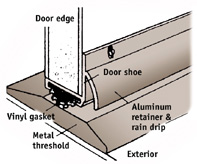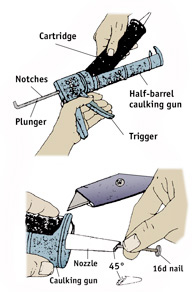 |
||

|
The average house–even when well-insulated–contains
cracks and gaps between building materials that add up to a hole about
14 "square (Fig. 1). In the winter, those gaps may make the house
drafty and chilly. All year long, a leaky house not only wastes energy,
but can lead to water damage and provide a path for insects. Inside this
document you will find information about:
|
|
|
|

WEATHERPROOFING BASICS

FIG. 1 - Where caulking should be applied, from the Sunset book, Insulation and Weatherstripping, © Sunset Publishing Corp. |
|
|
|
|

TYPES OF CAULKING
|
|
|
|
|
|
FIG. 2 - Loading a tube of caulking into a caulking gun, from Sunset's Home Repair Handbook, © Sunset Publishing Corp.  FIG. 3 - Whenever possible, push–don't pull–the caulking gun to drive caulk into the joint. Then tool the bead smooth, from the Sunset book, Roofing and Siding, © Sunset Publishing Corp. |

USING CAULKING
|
|
|
|
|
FIG. 4 - Applying caulking around doors and windows, from the Sunset book, Windows and Skylights, © Sunset Publishing Corp.  FIG. 5 - A door with compression weatherstripping.  FIG. 6 - Windows with V-type weatherstripping, from Sunset's Home Repair Handbook, © Sunset Publishing Corporation.  FIG. 7 - Doors with V-type weatherstripping, from Sunset's Home Repair Handbook, © Sunset Publishing Corp.  FIG. 8 - A door with foam weatherstripping, from Sunset's Home Repair Handbook, © Sunset Publishing Corp.  FIG. 9 - A door threshold with a combination rain drip/door bottom, from Sunset's Home Repair Handbook, © Sunset Publishing Corp. |

TYPES OF WEATHERSTRIPPING
|
|
|
|

INSTALLING WEATHERSTRIPPING
|

